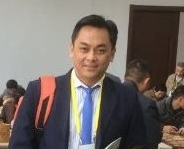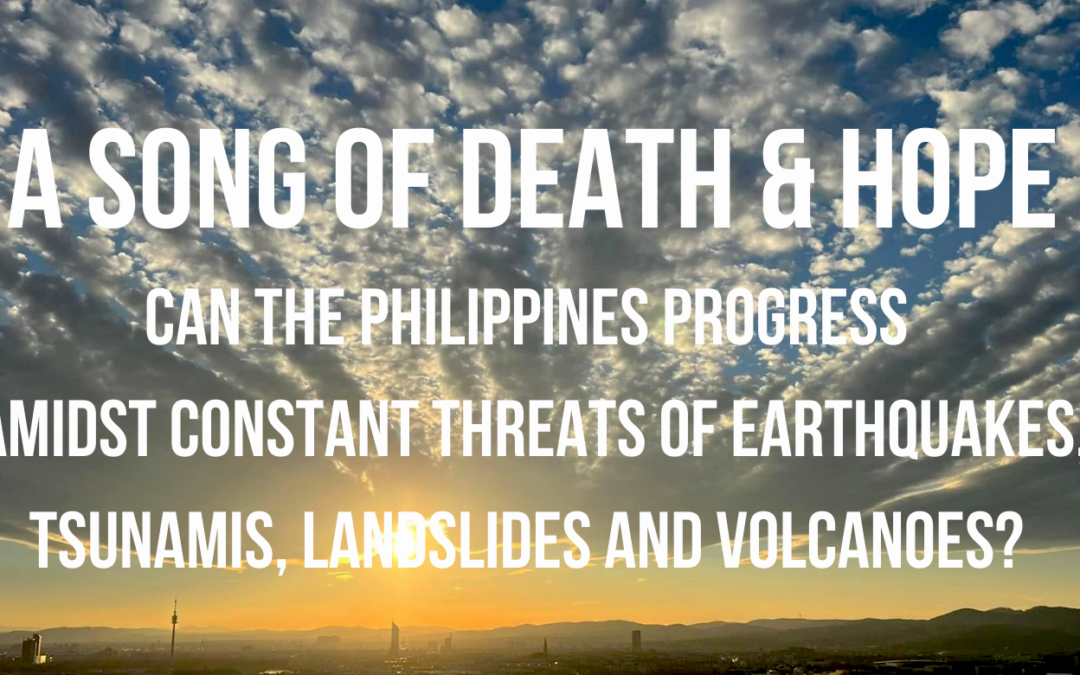And the consensus answer? A resounding yes… but with many ifs.
But let’s start at the beginning.
Dr. Baby Jane Punongbayan’s lecture, A Song of Death and Hope: Can the Philippines progress amidst constant threats of earthquakes, tsunamis, landslides and volcanos?, was held virtually on 25 February at 1:00 p.m. Vienna time. The lecture was part of a lecture series on science and technology promoted by the Philippine Austrian Cultural and Educational Society (PACES). The lecture was co-hosted by the Vienna International Centre (VIC) Club Filipino. Some 30 participants from Vienna, the Philippines, United Kingdom, and United States logged in to listen to her speak about the dangers of earthquakes, volcano eruptions and resulting tsunamis to the Philippines.

Dr. Punongbayan is a veteran Filipino seismologist, with extensive knowledge and mastery of the subject matter. She is an Associate Analyst with the Comprehensive Nuclear-Test-Ban Treaty Organization (CTBTO) in Vienna, helping to analyse seismic, hydroacoustic and infrasound events. Before that she was Supervising Science Research Specialist at the Philippine Institute of Volcanology and Seismology (PHIVOLCS), where she spent more than 22 years monitoring earthquake and tsunami events, and disseminating knowledge of disaster risk reduction and disaster preparedness among local government units, educators and the general public.
She began her lecture by stating that the geographic and geologic setting of the Philippines — as part of the Pacific Ring of Fire and the Earthquake Belt — makes the country prone to various hazards, including:
- Weather and climate-related;
- Volcanic-related;
- Earthquake-related; and
- Tsunamis
Noting that the Philippines will soon elect a new president, she traced the many disasters that have befallen the country since 1987, beginning with the term of then President Corazon Aquino. There have been six presidents and 24 calamities in the 15 years since then. This challenge will continue to face every sitting president because of how the country is geo-located, and constant effort will be needed to reduce disaster risks.
She explained that forces deep within the earth push out material from its core to the surface with heat and force, This produces volcanic activity and move the plates on which continents sit, resulting in earthquakes.
The Philippines sits right at the boundary between two colliding plates, and is therefore characterized by numerous earthquake fault lines throughout the country, as well as active and inactive volcanos, Dr. Punongbayan pointed out.
During her lecture, she showed several maps which showed the multiplicity of earthquake and volcanic hazards all throughout the Philippine archipelago. There are about 300 volcanos in the Philippines; with 23 of them considered to be active. Hazards from volcano eruptions can include ashfall, pyroclastic flow, lahar and volcanic flow. She then outlined the types of seismic hazards from earthquakes that people should be aware of. These include:
- Shaking of the ground;
- Landslides;
- Ground rupture when the ground itself tears apart;
- Ground liquefaction when the ground underneath buildings and structures is pulverised and loses its strength to support such structures; and
- Tsunamis which can result from undersea earthquakes.
However, the problem is that there is still no precise framework to predict when an earthquake would occur, Dr. Punongbayan said. The best we can do at the moment is to simply determine where that earthquake would strike and estimate the magnitude of the earthquake generated by a fault. The damaging effect of an earthquake can also be minimized by working with local government units and communities on disaster reduction measures.
Talking about the Big Ones
There are several big earthquakes predicted to hit different areas of the Philippines, the Valley Fault Magnitude of 7.2 hitting the Greater Metro Manila Area being one of them. Any of these predicted big earthquakes could kill hundreds of thousands in an instant. Dr. Punongbayan presented some scenarios under the Metro Manila Earthquake Impact Reduction Study of 2004 developed by PHIVOLCS in cooperation with Japan. Under the 7.2 magnitude scenario, that earthquake would cause 34,000 deaths with 120,000 injuries based on 2004 population figures.
So going back to the question posed at the beginning of this article: Can the Philippines still progress amidst all these threats hanging over it? When posed the question, many of the participants said yes, it can continue to progress despite these challenges. Dr. Punongbayan believes likewise, but only if the Philippines address the many ifs in the way. Here are some of them:
- If disaster risk reduction becomes a national priority, including creating a national framework for disaster risk reduction, better budget allocation and wiser use of funds.
- If there is better land use planning and strict implementation of plans.
- If the country supports better science and engineering, building the institutes and manpower needed for disaster risk control.
- If there will be more experts and devoted workers for disaster risk reduction.
- If awareness and preparedness will be taught to all, including earthquake drills and tsunami evacuation plans.
An uncommon field of study

In his remarks at the start of the lecture, Philippine Charge d’Affaires Frank Olea said that the topic of Dr. Punongbayan’s lecture is not a common topic for development studies as they deal with unforeseen and uncontrollable variables.
It remains relevant, however, in the context of the growing population density in urban areas, as more people move to cities for greener pastures.
In 2010, population density was at 308 people per square km. It increased to 337 people per sq km in 2015, then to 363 people per sq km in 2020, and finally to 368 people per square km this year, Mr. Olea pointed out. This increase in density of people may affect us once natural calamities strike.
Unfortunately, the Philippines is one of the most hazard prone countries in the world. When calamity strikes this can result in substantial socioeconomic costs due to population growth, change in land use patterns, migration, urbanization, environmental degradation, effects of climate change, and other factors.
The virtual lecture ended with Dr. Baby Jane Punongbayan asking the participants to sing together a rendition of Joh Lennon’s Imagine, a symbolic gesture on what could be possible when we all work together as one.
Dr, Punongbayan’s lecture was the ninth in a series of lectures on science and technology organized by PACES since 2016. The objective of the lecture series is to raise awareness, share knowledge, and harness existing experts in Vienna to inspire the 2nd and 3rd generations of Filipinos and Austrians, and help gain support for the scholarship program of PACES.


